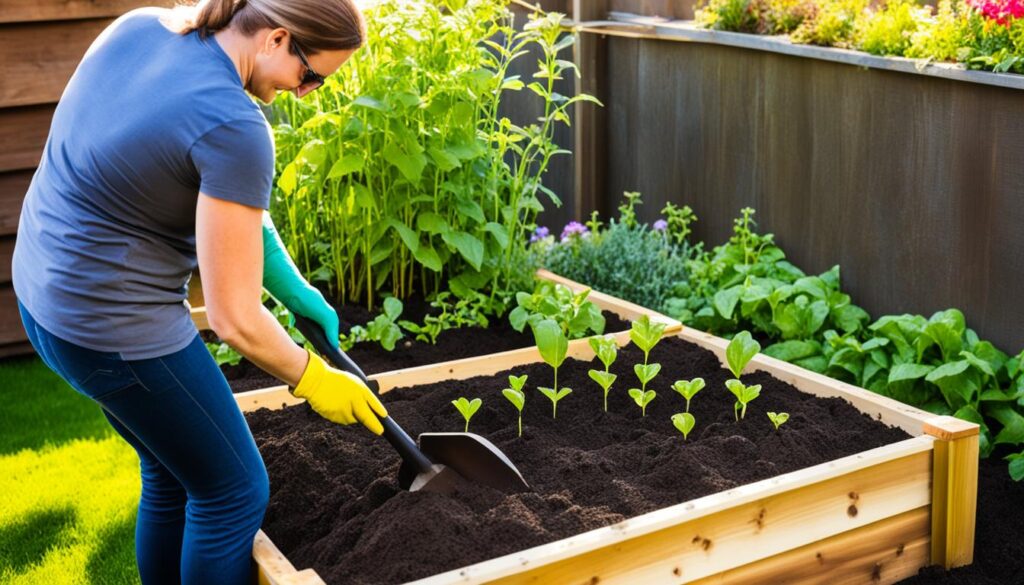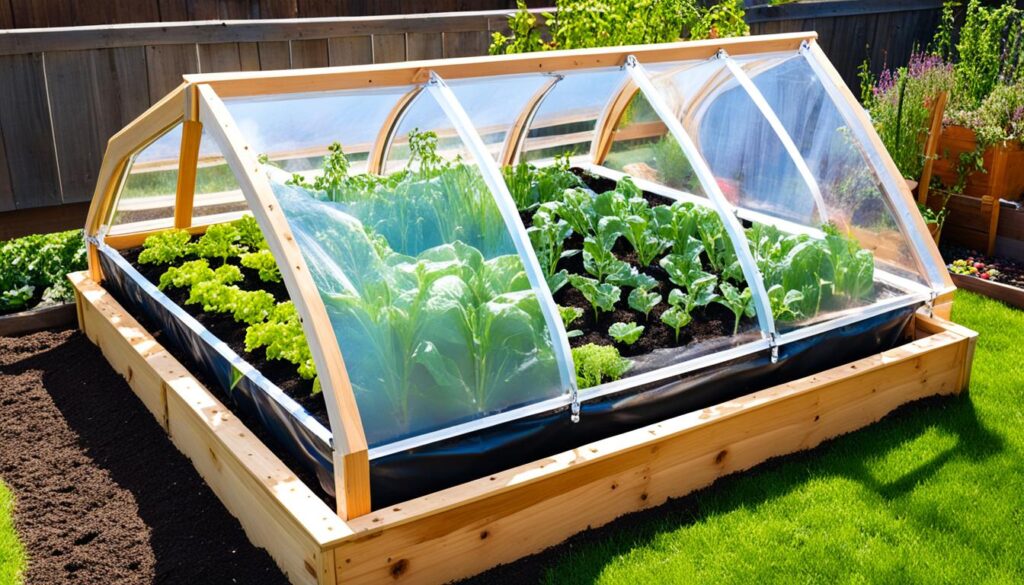Lime is essential for soil health and optimal plant growth in the garden. Adding lime to the soil provides numerous benefits, including adjusting soil pH, improving soil structure, and enhancing nutrient availability. By understanding the importance of using lime in the garden and how to apply it effectively, you can create a thriving garden with healthy plants. Let’s explore the benefits and tips for using lime in the garden.
Key Takeaways:
- Adding lime to the garden helps adjust soil pH, improve soil structure, and enhance nutrient availability.
- Lime neutralizes acidic soils, making them more suitable for a wide range of plants.
- Lime should be applied correctly based on soil pH testing to avoid over-liming.
- Applying lime in the autumn allows it to take effect over the winter months, preparing the soil for spring planting.
- Lime can be purchased from garden centres, nurseries, and online suppliers.
Importance of Using Lime in Soil
Lime plays a crucial role in maintaining proper soil pH. Soil pH affects nutrient availability, microbial activity, and plant growth. Acidic soils with a pH below 6.5 can hinder nutrient uptake by plants. By applying lime to acidic soil, you can raise the pH level and create a more balanced environment for plant growth. Lime also aids in the breakdown of organic matter, improves water infiltration, and enhances root development.
When soil pH is too acidic, essential plant nutrients such as nitrogen, phosphorus, and potassium become less available to plants. This can result in stunted growth, yellowing leaves, and overall poor plant health. By using lime to adjust soil pH to a more neutral or slightly alkaline range, you can ensure that plants have access to the nutrients they need for optimal growth and development.
Lime also plays a vital role in promoting microbial activity in the soil. Many beneficial soil organisms, such as earthworms and bacteria, thrive in neutral to alkaline pH levels. These microorganisms break down organic matter, releasing essential nutrients and improving soil structure. By providing a favorable pH environment for these microorganisms, you create a healthy soil ecosystem that supports plant growth.
Furthermore, the use of lime improves water infiltration in the soil. Acidic soils tend to become compacted and waterlogged, leading to poor drainage and root suffocation. Lime helps to flocculate clayey soils, allowing water to penetrate more easily and prevent waterlogging. This improved drainage promotes root development and prevents the risk of rot and disease.
Enhancing Root Development
One of the key benefits of using lime in soil is the enhancement of root development. When soil pH is too acidic, root growth is often stunted, and plants struggle to establish a strong and healthy root system. By raising the pH level with lime, plants can develop robust root systems that are better able to access water, nutrients, and oxygen in the soil. Strong roots provide a firm anchor for plants and contribute to overall plant health and productivity.
Using lime in soil is a valuable practice for gardeners and farmers alike. By maintaining optimal soil pH through the use of lime, you can ensure that your plants have the best possible environment for growth and productivity. Incorporating lime into your soil management routine can lead to healthier plants, increased yields, and a more thriving garden or farm.
Benefits of Lime in Gardening
Adding lime to the garden offers several benefits. Firstly, it neutralizes acidic soils, making them more suitable for a wide range of plants. This is particularly important for lime-loving vegetable crops like cabbage and broccoli, which thrive in slightly alkaline soil. Secondly, lime improves soil structure, especially in clay or compacted soils, by promoting the formation of larger soil crumbs. This allows for better water drainage and root penetration. Lastly, lime enhances nutrient availability for plants, as it helps to release trapped nutrients in the soil.
- Neutralizes acidic soils
- Improves soil structure
- Enhances nutrient availability
How to Apply Lime in Garden
Applying lime correctly is crucial to achieve optimal results in your garden. Before adding lime to your garden soil, it is recommended to test the soil pH using a soil testing kit. This will help determine if your soil requires lime and the appropriate amount to apply.
If you have annual crops, it is best to add lime in the winter, just before digging. This allows the lime to take effect over time. For perennial plants like lawns and shrubs, you can apply lime when the soil is acidic.
To apply lime, there are two common methods: digging and spreading. Digging involves incorporating the lime into the top 20cm of soil using a garden fork or spade. This ensures the lime is evenly distributed throughout the soil. Alternatively, you can use a spreader to apply lime evenly on the soil surface. Make sure to follow the recommended application rates based on your soil test results.
It is best to apply lime in the autumn, well in advance of spring sowing and planting. This allows enough time for the lime to adjust the soil pH before the growing season begins.
Proper Lime Application Process:
- Test your soil pH using a soil testing kit.
- Determine the appropriate amount of lime needed based on the soil test results.
- If you have annual crops, apply lime in the winter before digging.
- For perennial plants, apply lime when the soil is acidic.
- Use either the digging or spreading method to incorporate the lime into the soil.
- Apply lime in the autumn, well in advance of spring sowing and planting.
By following these steps, you can ensure that your lime application is effective and beneficial for your garden. Remember to always read and follow the instructions provided by the lime manufacturer for best results.
Choosing the Best Lime Products for Garden
When selecting lime products for your garden, it is essential to choose the right type. Garden lime, also known as ground limestone, is commonly used for gardening purposes. It contains calcium carbonate, which helps raise the soil pH. Another type is dolomitic lime, which contains magnesium in addition to calcium.
Dolomitic lime is recommended if your soil has low magnesium levels. It provides the necessary nutrients for plant growth and helps maintain a balanced pH level in the soil, promoting healthy root development and nutrient uptake.

Both types of lime can be easily purchased from garden centres, nurseries, and online suppliers. It is important to check the product label to ensure that it is suitable for use in gardens. Look for reputable brands and suppliers that offer high-quality lime products for optimal results.
The Benefits of Garden Lime:
- Raises soil pH to create a more balanced environment for plant growth
- Improves soil structure and drainage
- Enhances nutrient availability in the soil
- Promotes healthy root development
- Supports the growth of lime-loving plants
How to Choose the Right Lime Products:
- Consider the current pH level of your soil. If the soil is highly acidic, garden lime can help raise the pH to a more neutral level.
- If your soil has low magnesium levels, consider using dolomitic lime to provide the necessary nutrients for plant growth.
- Check the product label for instructions on application rates and recommended usage.
- Compare prices and reviews from different suppliers to ensure you are getting the best value for your money.
- Consult with gardening experts or professionals for personalized advice on choosing the right lime products for your specific garden needs.
By choosing the best lime products for your garden, you can ensure healthy plant growth and maximize the benefits of using lime in your gardening practices.
Assessing Soil pH Before Adding Lime
Before adding lime to your garden, it is crucial to assess the soil pH. Properly understanding the pH level of your soil will help you determine if lime application is necessary. To assess the soil pH, you can use inexpensive and simple soil testing kits available in garden centres. Conducting a soil pH test is especially important before designing or planting a new garden, establishing vegetable plots, or planting acidic-loving plants.
Soil pH levels above 7 indicate alkaline or lime-rich soil that does not require additional lime. On the other hand, soil with a pH below 7 is considered acidic and can greatly benefit from the application of lime. It helps to raise the pH level of acidic soil, creating a more balanced environment for plants to thrive.
By conducting a soil pH test, you can make informed decisions about when to add lime to your garden soil. The results will guide you in optimizing the pH levels and creating the ideal conditions for plant growth.
Soil pH Testing Process:
- Begin by obtaining a soil testing kit from your local garden centre or online supplier.
- Follow the instructions provided with the kit to collect soil samples from different areas of your garden.
- Use the testing equipment in the kit to determine the soil pH level.
- Compare the test results with the ideal pH range for the plants you intend to grow.
By following these steps and assessing the soil pH before adding lime, you can ensure that your plants have the right conditions for optimal growth and productivity.
Avoiding Excessive Lime Application
While lime is beneficial for the garden, it’s important to avoid excessive application. Adding too much lime can lead to excessively alkaline soil, which may cause nutrient deficiencies in plants. It can also result in high levels of calcium, preventing plants from absorbing essential nutrients like magnesium. To prevent over-liming, it is crucial to test the soil before adding lime and follow the recommended application rates based on the soil test results. It’s also advisable to grow plants that are better suited to your soil’s natural pH.

Tips for Using Lime in the Garden
- Perform a soil test: Before adding lime, test the soil pH to determine if lime is necessary and at what rate it should be applied. This will prevent over-liming and ensure optimal plant growth.
- Follow recommended application rates: Based on the soil test results, follow the recommended application rates provided by the soil testing kit or consult a gardening expert for guidance.
- Apply lime in moderation: Start with a smaller amount of lime and monitor the pH levels over time. Gradually adjust the amount if necessary to prevent over-liming.
- Consider plant preferences: Choose plants that are well-suited to your soil’s natural pH to avoid the need for excessive lime application.
- Monitor soil pH regularly: Regularly check the soil pH to ensure it remains within the desired range. Adjust lime application as needed.
By following these tips, you can effectively use lime in the garden while avoiding the drawbacks of excessive application.
Timing Lime Application
The timing of lime application is crucial for its effectiveness. While lime can be applied at any time of the year, it is best to apply it in the autumn. This allows the lime to take effect over the winter months, preparing the soil for spring planting and growth. Applying lime well in advance allows it to mix into the soil during the freeze/thaw cycle. By timing lime application correctly, you ensure that it has enough time to adjust the soil pH and provide maximum benefit to your plants.
When determining the best time to add lime to your garden soil, consider the following factors:
- Soil Test Results: Before applying lime, it is advisable to test your soil using a soil testing kit. This will help determine the current pH levels and whether lime is necessary. If the soil pH is below 6.5, it indicates acidity, and lime can be beneficial.
- Garden Preparation: Applying lime in autumn allows it to mix into the soil during the winter freeze/thaw cycle. This ensures that the lime is well-distributed and can adjust the pH effectively before the spring planting season.
- Crop Rotation: If you follow a crop rotation schedule, it is best to apply lime when preparing the soil for crops that prefer neutral or alkaline pH levels. This will provide an optimal growing environment for these crops.
- Perennial Plant Care: For perennial plants like lawns and shrubs, consider applying lime when the soil pH is acidic. This will help maintain a suitable pH level for their growth and overall health.
By timing lime application correctly, you can ensure that your garden soil has the necessary pH balance for healthy plant growth. Remember to follow the recommended application rates based on the soil test results and consult with a gardening expert if you have any specific concerns or questions.
Precautions and Advice for Using Lime
When using lime in the garden, it is important to take certain precautions. Here are some tips for using lime in the garden to ensure successful application:
- Choose the right day: Apply lime on a dry, windless day when the soil is damp or fairly dry but not wet. This will allow the lime to spread easily and prevent it from clumping.
- Protective clothing: Wear protective clothing, including gloves and a dust mask, when handling lime. This will prevent direct contact with the skin and inhalation of lime dust, which can irritate the respiratory system.
- Avoid mixing with manure: It is vital to avoid combining lime with manure in the garden. This is because lime can react with the nitrogen in manure, leading to nutrient imbalances and potential root damage. Keep lime and manure separate when applying them to the garden.
- Use garden lime: Make sure to buy garden lime specifically designed for garden use. Industrial quicklime, which is not suitable for gardening purposes, should be avoided. Garden lime, such as ground limestone or dolomitic lime, is readily available from garden centres, nurseries, and online suppliers.

Where to Buy Garden Lime
Looking to buy garden lime? You’ll be happy to know that it is widely available from various sources in the United Kingdom. Whether you prefer to shop in person or online, you’ll find garden lime at your convenience.
Garden centres and nurseries are excellent places to start your search. They typically stock different brands and sizes of garden lime to suit your needs. You can browse their selection and get expert advice from knowledgeable staff who can help you make the right choice.
If you prefer the convenience of online shopping, there are reputable online suppliers that offer a wide range of garden lime products. Thompson & Morgan and Suttons are highly recommended options. They provide a variety of garden lime sizes, ranging from 3kg to 25kg, so you can purchase the quantity that suits your gardening requirements.
Remember, when purchasing garden lime, always choose the appropriate type for your soil’s needs and follow the recommended application rates. With easy access to garden lime, you’ll be well on your way to creating a healthy and thriving garden.








